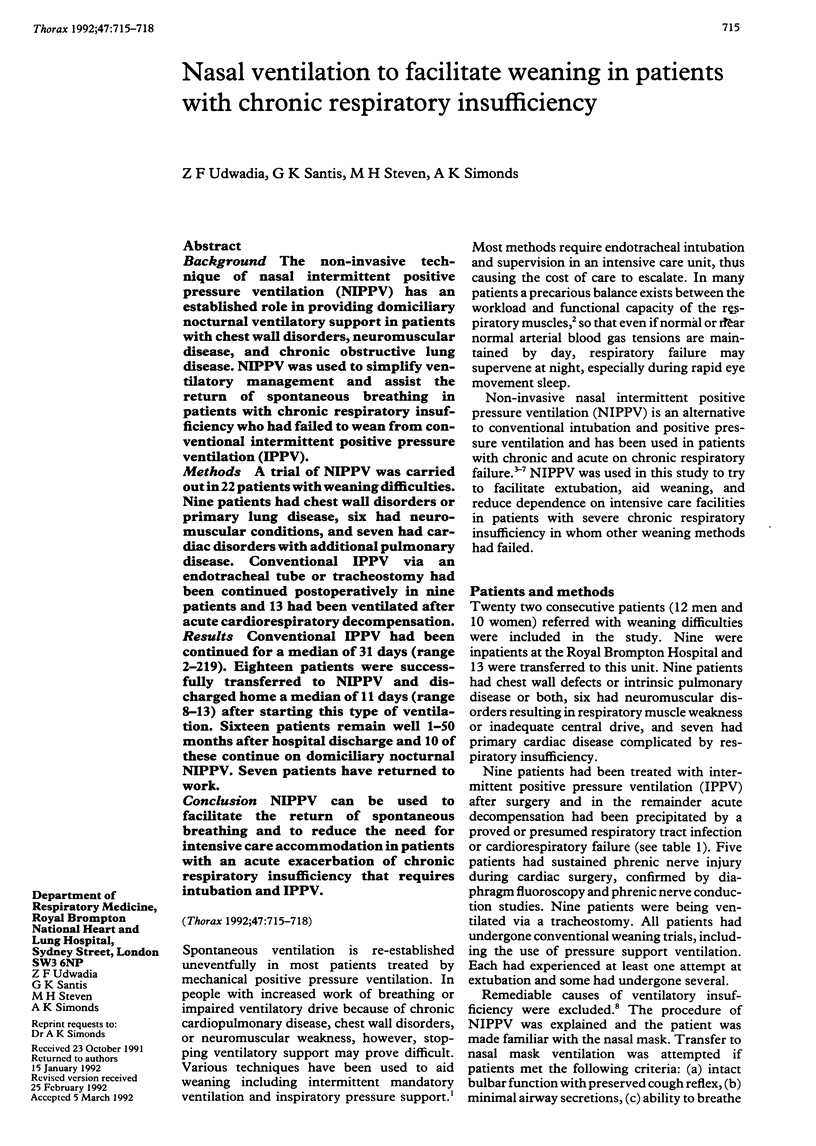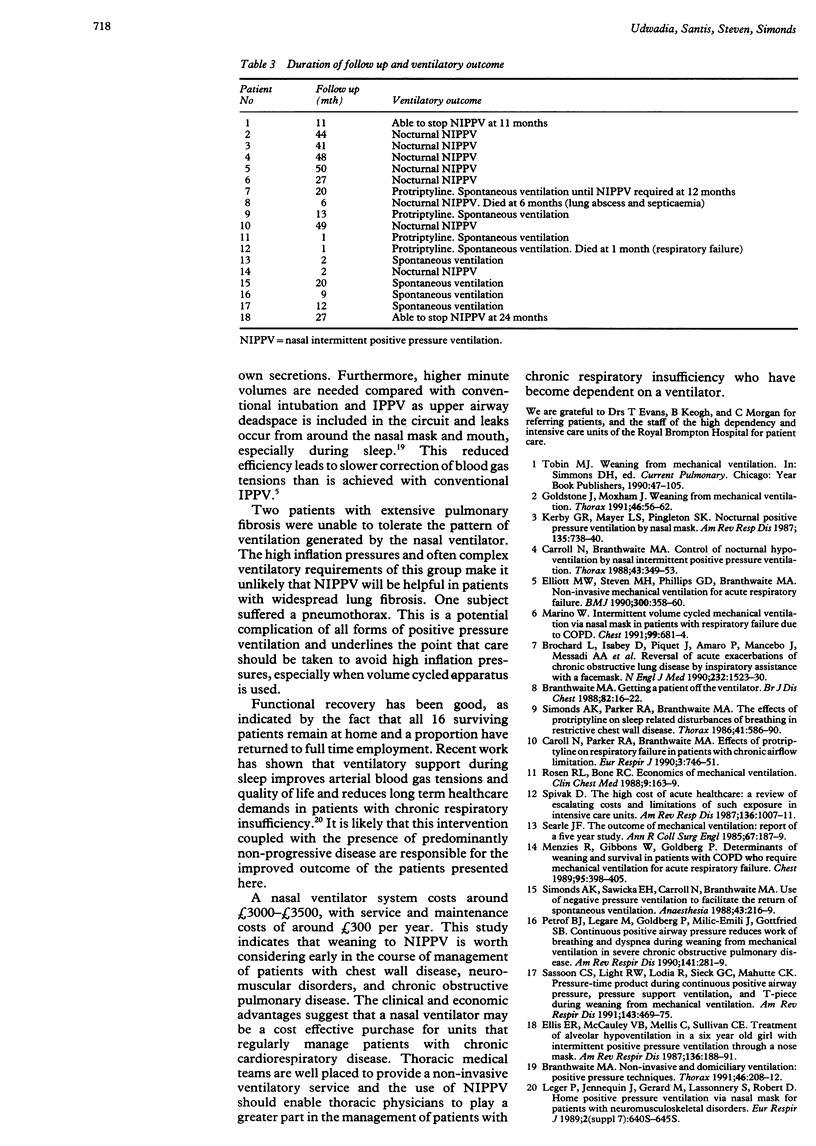Abstract
BACKGROUND: The non-invasive technique of nasal intermittent positive pressure ventilation (NIPPV) has an established role in providing domiciliary nocturnal ventilatory support in patients with chest wall disorders, neuromuscular disease, and chronic obstructive lung disease. NIPPV was used to simplify ventilatory management and assist the return of spontaneous breathing in patients with chronic respiratory insufficiency who had failed to wean from conventional intermittent positive pressure ventilation (IPPV). METHODS: A trial of NIPPV was carried out in 22 patients with weaning difficulties. Nine patients had chest wall disorders or primary lung disease, six had neuromuscular conditions, and seven had cardiac disorders with additional pulmonary disease. Conventional IPPV via an endotracheal tube or tracheostomy had been continued postoperatively in nine patients and 13 had been ventilated after acute cardiorespiratory decompensation. RESULTS: Conventional IPPV had been continued for a median of 31 days (range 2-219). Eighteen patients were successfully transferred to NIPPV and discharged home a median of 11 days (range 8-13) after starting this type of ventilation. Sixteen patients remain well 1-50 months after hospital discharge and 10 of these continue on domiciliary nocturnal NIPPV. Seven patients have returned to work. CONCLUSION: NIPPV can be used to facilitate the return of spontaneous breathing and to reduce the need for intensive care accommodation in patients with an acute exacerbation of chronic respiratory insufficiency that requires intubation and IPPV.
Full text
PDF



Images in this article
Selected References
These references are in PubMed. This may not be the complete list of references from this article.
- Branthwaite M. A. Assisted ventilation 6. Non-invasive and domiciliary ventilation: positive pressure techniques. Thorax. 1991 Mar;46(3):208–212. doi: 10.1136/thx.46.3.208. [DOI] [PMC free article] [PubMed] [Google Scholar]
- Branthwaite M. A. Getting a patient off the ventilator. Br J Dis Chest. 1988 Jan;82(1):16–22. doi: 10.1016/0007-0971(88)90004-6. [DOI] [PubMed] [Google Scholar]
- Brochard L., Isabey D., Piquet J., Amaro P., Mancebo J., Messadi A. A., Brun-Buisson C., Rauss A., Lemaire F., Harf A. Reversal of acute exacerbations of chronic obstructive lung disease by inspiratory assistance with a face mask. N Engl J Med. 1990 Nov 29;323(22):1523–1530. doi: 10.1056/NEJM199011293232204. [DOI] [PubMed] [Google Scholar]
- Carroll N., Branthwaite M. A. Control of nocturnal hypoventilation by nasal intermittent positive pressure ventilation. Thorax. 1988 May;43(5):349–353. doi: 10.1136/thx.43.5.349. [DOI] [PMC free article] [PubMed] [Google Scholar]
- Carroll N., Parker R. A., Branthwaite M. A. The use of protriptyline for respiratory failure in patients with chronic airflow limitation. Eur Respir J. 1990 Jul;3(7):746–751. [PubMed] [Google Scholar]
- Elliott M. W., Steven M. H., Phillips G. D., Branthwaite M. A. Non-invasive mechanical ventilation for acute respiratory failure. BMJ. 1990 Feb 10;300(6721):358–360. doi: 10.1136/bmj.300.6721.358. [DOI] [PMC free article] [PubMed] [Google Scholar]
- Ellis E. R., McCauley V. B., Mellis C., Sullivan C. E. Treatment of alveolar hypoventilation in a six-year-old girl with intermittent positive pressure ventilation through a nose mask. Am Rev Respir Dis. 1987 Jul;136(1):188–191. doi: 10.1164/ajrccm/136.1.188. [DOI] [PubMed] [Google Scholar]
- Goldstone J., Moxham J. Assisted ventilation. 4. Weaning from mechanical ventilation. Thorax. 1991 Jan;46(1):56–62. doi: 10.1136/thx.46.1.56. [DOI] [PMC free article] [PubMed] [Google Scholar]
- Kerby G. R., Mayer L. S., Pingleton S. K. Nocturnal positive pressure ventilation via nasal mask. Am Rev Respir Dis. 1987 Mar;135(3):738–740. doi: 10.1164/arrd.1987.135.3.738. [DOI] [PubMed] [Google Scholar]
- Leger P., Jennequin J., Gerard M., Lassonnery S., Robert D. Home positive pressure ventilation via nasal mask for patients with neuromusculoskeletal disorders. Eur Respir J Suppl. 1989 Jul;7:640s–644s. [PubMed] [Google Scholar]
- Marino W. Intermittent volume cycled mechanical ventilation via nasal mask in patients with respiratory failure due to COPD. Chest. 1991 Mar;99(3):681–684. doi: 10.1378/chest.99.3.681. [DOI] [PubMed] [Google Scholar]
- Menzies R., Gibbons W., Goldberg P. Determinants of weaning and survival among patients with COPD who require mechanical ventilation for acute respiratory failure. Chest. 1989 Feb;95(2):398–405. doi: 10.1378/chest.95.2.398. [DOI] [PubMed] [Google Scholar]
- Petrof B. J., Legaré M., Goldberg P., Milic-Emili J., Gottfried S. B. Continuous positive airway pressure reduces work of breathing and dyspnea during weaning from mechanical ventilation in severe chronic obstructive pulmonary disease. Am Rev Respir Dis. 1990 Feb;141(2):281–289. doi: 10.1164/ajrccm/141.2.281. [DOI] [PubMed] [Google Scholar]
- Rosen R. L., Bone R. C. Economics of mechanical ventilation. Clin Chest Med. 1988 Mar;9(1):163–169. [PubMed] [Google Scholar]
- Sassoon C. S., Light R. W., Lodia R., Sieck G. C., Mahutte C. K. Pressure-time product during continuous positive airway pressure, pressure support ventilation, and T-piece during weaning from mechanical ventilation. Am Rev Respir Dis. 1991 Mar;143(3):469–475. doi: 10.1164/ajrccm/143.3.469. [DOI] [PubMed] [Google Scholar]
- Searle J. F. The outcome of mechanical ventilation: report of a five year study. Ann R Coll Surg Engl. 1985 May;67(3):187–189. [PMC free article] [PubMed] [Google Scholar]
- Simonds A. K., Parker R. A., Branthwaite M. A. Effects of protriptyline on sleep related disturbances of breathing in restrictive chest wall disease. Thorax. 1986 Aug;41(8):586–590. doi: 10.1136/thx.41.8.586. [DOI] [PMC free article] [PubMed] [Google Scholar]
- Simonds A. K., Sawicka E. H., Carroll N., Branthwaite M. A. Use of negative pressure ventilation to facilitate the return of spontaneous ventilation. Anaesthesia. 1988 Mar;43(3):216–219. doi: 10.1111/j.1365-2044.1988.tb05545.x. [DOI] [PubMed] [Google Scholar]
- Spivack D. The high cost of acute health care: a review of escalating costs and limitations of such exposure in intensive care units. Am Rev Respir Dis. 1987 Oct;136(4):1007–1011. doi: 10.1164/ajrccm/136.4.1007. [DOI] [PubMed] [Google Scholar]



